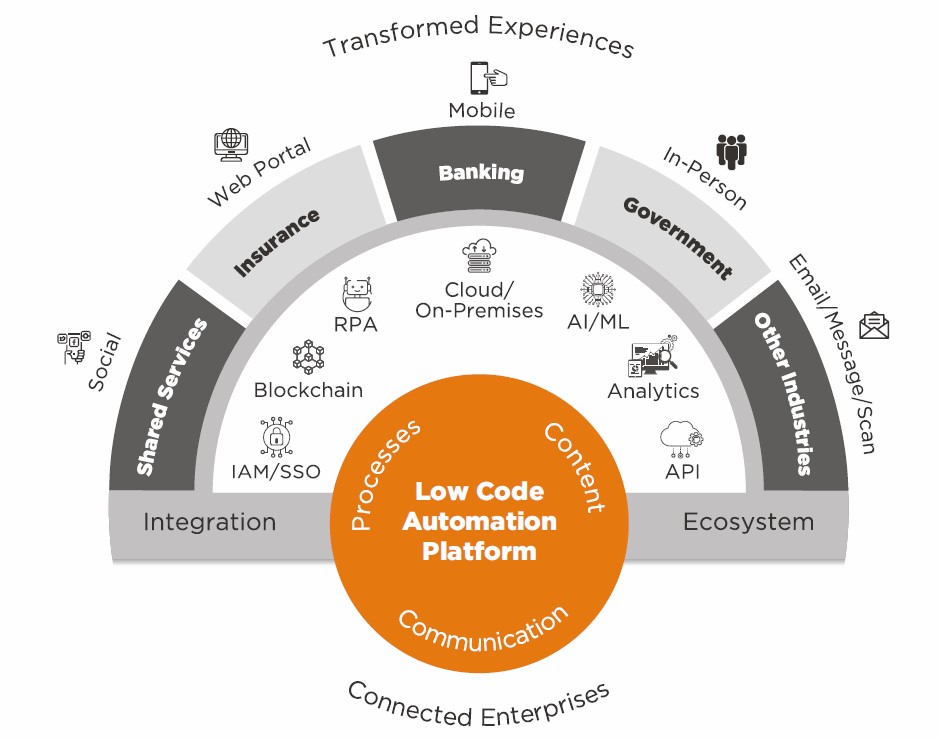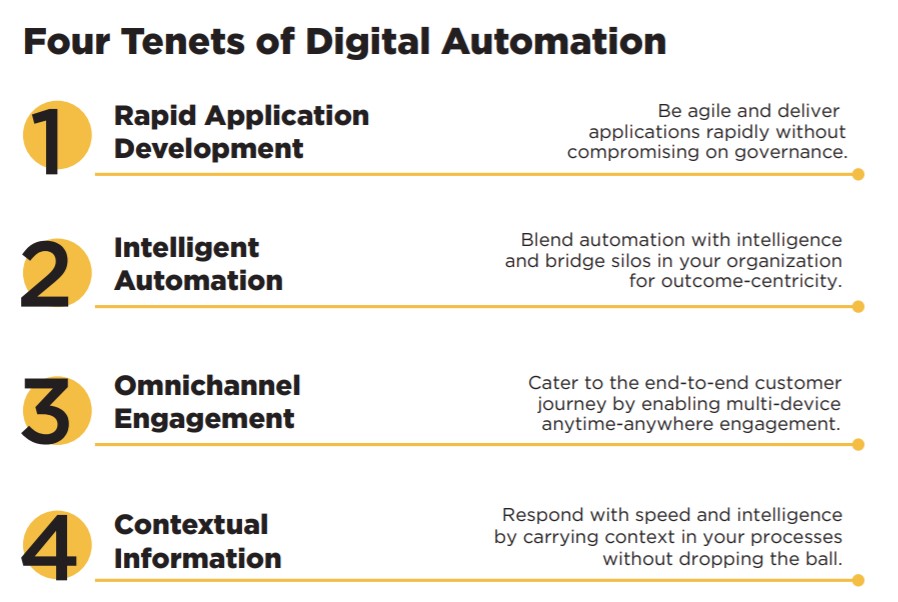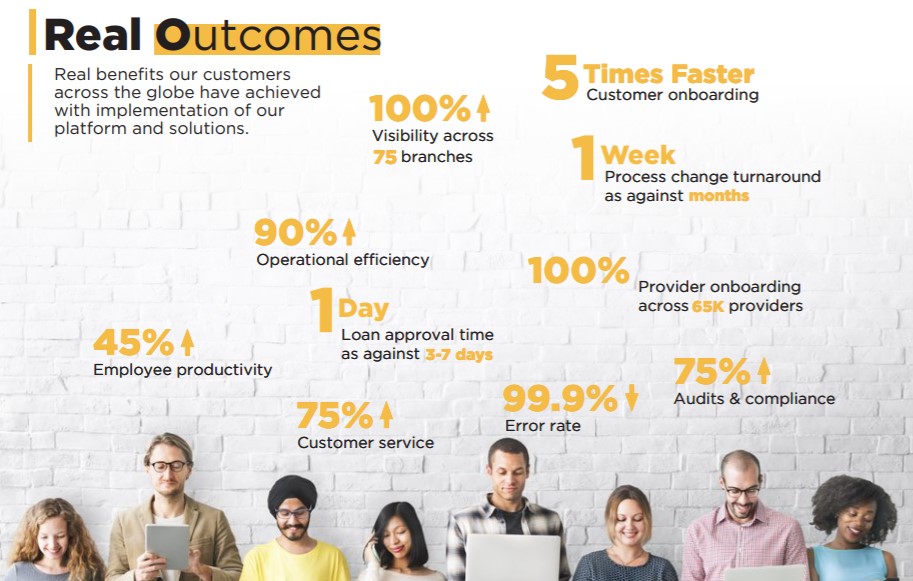GARTNER predicts:
“By 2024, low-code application development will be responsible for more than 65% of application development activity.”
Translating business requirements to applications is a time-consuming and challenging process. With organizations going digital, the demand-supply gap of business applications is expected to widen. This requires organizations to take a transformative approach- moving away from coding to building and deploying applications faster.
Low-code app development is gaining a lot of traction right now – and for good reason. This technology makes it easier on those with limited experience to build applications for both web and mobile.
According to Gartner, low-code will be responsible for more than 65% of application development activity by 2024 and the pressure to deliver digital solutions to respond to the COVID-19 pandemic has only accelerated this adoption. To comprehend the increasing popularity of this development approach, it’s important to understand the concept of low-code, the composition of low-code platforms, and what problems low-code solves.
What is Low Code App Development?

Low-code development is a general term that includes process development solutions, low-code application development, and software development tools.
Low-code app development solutions provide building blocks that IT users can assemble into workflows and applications. These building blocks abstract away the code behind actions and commands, making it possible for IT to assemble workflows and business apps without the need for hand-coding.
Low-code is a visual approach to software development. Low-code abstracts and automates every step of the application lifecycle to enable rapid delivery of a variety of software solutions. It breaks the traditional silos of business and IT to promote continuous collaboration.
Whether its business users creating an app themselves or simplifying the development process for coders by automating manual processes, low-code development makes it easier than ever to create flexible apps to get specific tasks done.
Here’s what a typical low-code app development platform looks like:
- A visual IDE (Integrated Development Environment)
An environment for visually defining the UIs, workflows, and data models of your application and, where necessary, adding hand-written code.
- Connectors to various back-ends or services
Automatically handles data structures, storage, and retrieval.
- Application lifecycle manager
Automated tools for building, debugging, deploying, and maintaining the application in test, staging, and production.
What Problem does Low Code App Development solve?

The pressure on IT organizations to deliver innovative solutions keeps magnifying. However, only a small group of top-tier companies have the financial and human resources to meet the market demand for speed with traditional development.
Most companies are buried under enormous backlogs, struggling to hire sufficiently qualified staff, and they are continuously asked to do more with less. In addition, if there’s one thing the pandemic taught us it’s that the agility to adapt to new and unpredictable demands is crucial for business survival.
Because low-code dramatically reduces the complexity of software development, companies of any size that adopt this approach have the power to increase developer productivity and speed. It elevates the value of developers, enabling agile teams to draw on their understanding of how to create and maintain high-quality web and mobile applications while flexing their wings by trying new technology. With low-code, a UI/UX designer can do front-end development and a back-end developer can try prototyping a consumer app.
Put more simply, low-code is a way for developers to get more done. With low-code, they can spend more time creating and building and less time on repetitive work.
Low-code development platforms enable IT to quickly assemble new processes and build applications without having to research, write, and test new scripts. Just as important, IT professionals don’t need to have specialized knowledge of every tool or technology involved in a set of processes because the code is abstracted away. With the right low-code tool, just about any IT team member can develop reliable, cross-platform business processes and accelerate application delivery.
Benefits of Low Code App Development

Low-code development is a term given to a broad range of tools that can be used to develop anything from IT processes to business software. That said, there are a few features that most low-code development platforms have in common, including:
- Direct integrations and low-code API accessibility
- Drag-and-drop workflow designers
- Workflow testing/prototyping facilities
Depending on the platform, a low-code development tool can also include monitoring, resource management, and advanced tools that help streamline devops. But whether you are looking to deploy an application development platform or a more expansive solution that unifies enterprise processes, low-code development provides a number of benefits to the organization:
- Lower Barrier To Entry, Cost And Deployment Time: Low-code development will lower the barrier to entry, cost and time to deployment. You no longer need expert coders for full development, but could use experts in a field with some coding training. For example, doctors and nurses could help code and deploy a workflow instead of a programmer with no medical background, solving the problem the app or workflow is addressing more completely.
- Legacy Integration: It’s well known that low-code platforms increase agility in app development. Low-code platforms are also available for integration of legacy mainframe systems. They bring the same benefits, including faster development, more resilient solutions and the ability to quickly adapt to new requirements.
- Rapid Assembly Of Solutions By A Nontechnical Audience: In a hyper-personalized world, creating new solutions fast that behave similarly across an omnichannel ecosystem is a game-changer. Low-code software platforms fast-track digital programs by enabling a wider, nontechnical audience to rapidly assemble solutions. Aside from the availability of platforms that are growing, the excitement is that it breaks down traditional organizational boundaries.
- Speeding Up Development Cycles: Low-code app development is lowering the barrier to entry for innovation. People with no coding experience can now create digital products. Besides this, it’s also expediting development cycles. Flawlessly functioning products and visually appealing designs can be created in a matter of minutes instead of weeks. That’s game-changing.
- Automating Any Business Idea In Minutes: We are building a world where any business idea can be automated in minutes. This is the most exciting benefit of low-code development unveils for organizations. Within five years, everyone will be a developer thanks to the technology. From software customization to complex apps, low-code is capable of equipping any employee with powerful tools for improved operational efficiency.
- Lower Maintenance Burden: Low-code development reduces the burden of software maintenance by abstracting the tedious plumbing work from day-to-day development. Now that components are standardized, pretested and ready-made, there are far fewer bugs and integration issues to deal with than in the past. By spending less time on maintenance, developers can focus on innovative work that drives greater business value.
- The Rise of the Citizen Developer: With today’s constant demand for software and apps, most IT departments simply can’t keep up. Enter citizen developers, nonprofessionals building business apps with existing tools sanctioned by corporate IT. With less code and a simpler development path, citizen developers can quickly create much-needed apps. This building-block approach cuts development time, translating to faster time-to-value.
- Increased Productivity Across Teams: Low-code development bridges the gap between IT and business teams so that both can solve real issues that impact the company. Business teams can create their own applications, without waiting for developers. Taking away complex code increases access to more team members regardless of skill, which enhances productivity. New ideas can be launched and iterated more quickly.
- Democratization Of Software Development: It will grant users access to technical or business expertise, such as data analysis, machine learning or app development due to a slighter learning curve. It’s no longer necessary to be a senior developer to use highly specialized tools and systems in your work.
- Bridging the Tech Divide: Low-code platforms enable agility and faster, more accessible development cycles. They also bridge the tech divide to democratize and accelerate innovation. The latest visual programming techniques offered by low-code platforms empower business users (who understand their workflows and processes best) to directly build and iterate on solutions that boost their efficiency and productivity.
- Rapid Prototyping: One benefit of low-code app development is it allows non-coders to prototype solutions quickly. These solutions can be tested, evaluated and refined without having to involve formal software development staff members. Competing solutions can be compared, discarded or merged to the point when they are deemed mature enough to be passed on to development for a more optimal implementation.
- Faster Innovation and Development: Low-code app development enables people without technical backgrounds to develop innovative apps and can help speed time to develop. However, it’s still important for mobile app developers to ensure strong security and in-app protection are always built-in from the design stage and not omitted for the sake of speed or convenience.
Citizen Development Made Easy with NEWGEN’s Low Code Digital Automation Platform

Newgen‘s digital automation platform, with low code capability, reduces the effort required to translate business requirements into applications. It empowers citizen developers to easily build applications for automating simple departmental functions to complex enterprise-wide solutions.
- Low Code Process Designer
Design end-to-end process workflows with drag-and-drop activities, exceptions and alerts configurations, process specific input data, business rules, decision-based routings, and status change notifications.
Business users can quickly learn the basics of process designing and can start building process workflows as required and standardize the existing processes with better governance and data visibility.
- Low Code Mobile App Builder
Develop, deploy, and manage highly configurable, hybrid mobile applications that can support multiple platforms. Leverage the low code app development platform to break silos, integrate mobile processes with backend systems, and offer a collaborative mobile environment.
You can bolster your growth strategy by offering products and services using mobile apps across different lines of business.
With the combined power of low code and mobility, Newgen can help your organization move beyond traditional application development and embrace citizen development.

Newgen’s platform has been enabling enterprises across industries, including banking, insurance, government, telecom, manufacturing, and healthcare. It is enriched with advanced features for data capture, security, and document processing.
Newgen’s low code digital automation platform enables digital transformation by integrating critical capabilities through their flagship products in intelligent process automation (BPM), contextual content services (ECM), and omnichannel customer engagement (CCM).
On one hand, the platform helps you transform experiences by bridging process, content, and communication silos across your organization. On the other hand, it offers you the agility for sustainable and continuous improvement, thereby future-proofing your enterprise.

Furthermore, Newgen’s architectural support for integration and innovation enables you to leverage cutting-edge capabilities to stay ahead of the curve. Such capabilities include mobility, social, analytics, cloud, machine learning, robotic process automation, blockchain, and artificial intelligence.
Who can be Citizen Developers in your Organization?

Citizen developers of low code app development are business users with a keen interest in software development, who can leverage low code to rapidly build their own application prototypes.
Subject matter experts, IT administrators, and business analysts can all be transformed into the best citizen developers, considering their strong industry experience and domain knowledge. And you can fuel their desire to learn more and create applications by empowering them with a low code development platform.
The number of business users that can be potential citizen developers far outweighs the number of software developers that are available at your disposal. This, in itself, solidifies citizen development as a lucrative opportunity that can enable you to maximize your existing investments.
With the right set of low code development tools and a digital automation platform, any business user can become a citizen developer and create web, mobile, and cloud-based applications in a shorter timeframe.
Ready to Give Low Code App Development a Try?

From lower IT costs to a more agile business posture, the benefits of low-code development platforms are well-documented. The ability to build and deploy apps quickly and efficiently can be a game-changer. Newgen’s low-code application development environment gives enterprises an edge by giving citizen developers, developers, and IT exactly the tools they need – when and where they need them.
Schedule a demo to watch our experts run jobs that match your use cases in Newgen’s Digital Automation Platform.
Author



